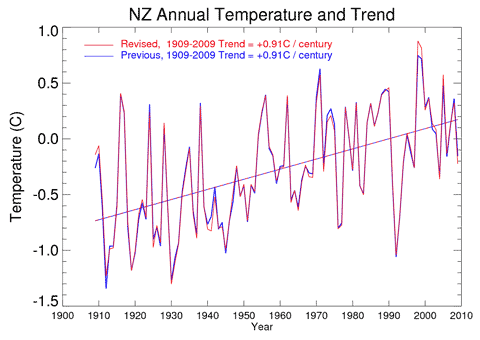 When one spends a good deal of time following what scientists working on climate change are saying, it’s hard to understand how the community at large and politicians in particular can appear so unaffected by the prospect ahead if we don’t radically reduce our greenhouse gas emissions. The only conclusion is that they haven’t yet understood the full reality of the science.
When one spends a good deal of time following what scientists working on climate change are saying, it’s hard to understand how the community at large and politicians in particular can appear so unaffected by the prospect ahead if we don’t radically reduce our greenhouse gas emissions. The only conclusion is that they haven’t yet understood the full reality of the science.
James Hansen is notably one scientist who has been much exercised by this fact. He and his co-writers offer some reflections on the communication of the status of global warming to the public in a summary discussion at the end of their revised paper Global Surface Temperature Change, which has been accepted for publication in Reviews of Geophysics. The comments on communication are carefully characterised as opinion and differentiated from the primary scientific contribution of the paper. But it is entirely understandable that scientists should be exercised about why there appears to be so much difficulty having a subject of such “surpassing importance” communicated clearly to the public.
The paper notes first that weather variability hampers lay people’s perceptions, a difficulty which can best be addressed by drawing attention to the changes in frequency and magnitude of changes from the norm apparent on decadal time scales as warming increases.
The writers then remark the media’s difficulties in framing long-term problems as news, the preference for sensationalism, the generally low level of familiarity with basic science, and the preference for ‘balance’ in every story.
The politicisation of reporting of global warming compounds these difficulties. The paper acknowledges that politicisation is perhaps inevitable given the economic and social implications of altering the course of human-made climate change. Alleviating it is made more difficult by attacks on the character and credibility of scientists, which appear to have been effective in causing many in the public to doubt the reality or seriousness of climate change.
What can scientists do about this? Keep on keeping on:
“…the best hope may be repeated clear description of the science and passage of sufficient time to confirm validity of the description.”
Hansen acknowledges the danger is that while we wait for this to happen the climate system could pass tipping points that cause major climate changes to proceed largely out of humanity’s control.
“Yet continuation of careful scientific description of ongoing climate change seems to be essential for the sake of minimizing the degree of future climate change, even while other ways are sought to draw attention to the dangers of continued greenhouse gas increases.”
The paper, these reflections apart, continues precisely such careful scientific description, updating and discussing the Goddard Institute’s analysis of global surface change and showing that contrary to popular misconception the rate of warming has not declined.
“Global warming on decadal time scales is continuing without letup… we conclude that there has been no reduction in the global warming trend of 0.15-0.20°C/decade that began in the late 1970s.”
The Australian Academy of Science last week produced a worthy effort to communicate the science with the publication of Climate Change: Questions and Answers (web, pdf). It is a lucid account for the lay reader of the central features of climate science as currently understood by its practitioners. In his foreword the President of the Academy, Kurt Lambeck, points to some of the complexities which beset the communication of climate science. It is at the intersection of a number of science disciplines and sub-disciplines.
“It is at this intersection of the disciplines where uncertainty can and will arise, both because of the yet poorly understood feedbacks between the different components of the climate system and because of the difficulty of bringing these components together into a single descriptive and predictive model.”
Equal complexities may be evident in many other areas of experimental science, but they bear special weight in climate:
“What makes climate change different is that the consequences are not only potentially global and serious but also that they occur over long time scales (decades to centuries) so that actions need to be contemplated before full understanding is achieved.”
The Academy has produced the document to try to aid public understanding and to tread a path through the often contradictory public commentary on the science. Lambeck emphasises that it is not intended as a formulation of a public response, but as “an attempt to improve the public understanding of the science upon which any policy response should be constructed.”
The document is a model of clarity in its explanations of the science and restrained in its presentation of the impacts of global warming. Look at the careful language which communicates truly alarming but well-founded predictions:
“If emissions continue unabated, current mid-range estimates are for 4.5°C higher global average temperatures by 2100 which would mean that the world would be hotter than at any time in the last few million years. Sea level would continue to rise for many centuries. The impacts of such changes are difficult to predict, but are likely to be severe for human populations and for the natural world. The further climate is pushed beyond the envelope of relative stability that has characterised the last several millennia, the greater becomes the risk of passing tipping points that will result in profound changes in climate, vegetation, ocean circulation or ice sheet stability.”
What policy response should be constructed on that? A 5% reduction in emissions in Australia by 2020 from a 2000 base says Tony Abbott, who prevaricates on whether humans are causing climate change. It depends what a citizen’s assembly comes up with says Julia Gillard, who affirms she believes in human-caused climate change.
Scientific bodies must use measured language. But it shouldn’t be asking too much of policy makers and the educated public to translate it into the urgent awareness that it demands from anyone who takes the trouble to attend to it. How much longer will that be delayed?
[Harry Lauder!]
Like this:
Like Loading...
 The National Institute for Water and Atmospheric Research (NIWA) released details of its recalculated New Zealand temperature series last week and in the last couple of days Richard Treagold and the Climate “Science” Coalition have issued statements in reply. And what a contrast they provide: Bryan Leyland for the NZ C”S”C is all bluster, demanding the resignation of the NIWA chairman and a declaration that the new series is “not valid” (whatever that means). Treadgold, meanwhile, describes the NIWA study as a vindication of his original “report”. One hopes they attend different carol services, because they’re clearly singing from different hymnals.
The National Institute for Water and Atmospheric Research (NIWA) released details of its recalculated New Zealand temperature series last week and in the last couple of days Richard Treagold and the Climate “Science” Coalition have issued statements in reply. And what a contrast they provide: Bryan Leyland for the NZ C”S”C is all bluster, demanding the resignation of the NIWA chairman and a declaration that the new series is “not valid” (whatever that means). Treadgold, meanwhile, describes the NIWA study as a vindication of his original “report”. One hopes they attend different carol services, because they’re clearly singing from different hymnals.

 One of Hot Topic’s favourite sceptics is NZ C”S”C member Roger Dewhurst, best known for turning up from time to time to unload links to the denier meme du jour (and for his carefully cultivated
One of Hot Topic’s favourite sceptics is NZ C”S”C member Roger Dewhurst, best known for turning up from time to time to unload links to the denier meme du jour (and for his carefully cultivated 
 When one spends a good deal of time following what scientists working on climate change are saying, it’s hard to understand how the community at large and politicians in particular can appear so unaffected by the prospect ahead if we don’t radically reduce our greenhouse gas emissions. The only conclusion is that they haven’t yet understood the full reality of the science.
When one spends a good deal of time following what scientists working on climate change are saying, it’s hard to understand how the community at large and politicians in particular can appear so unaffected by the prospect ahead if we don’t radically reduce our greenhouse gas emissions. The only conclusion is that they haven’t yet understood the full reality of the science.